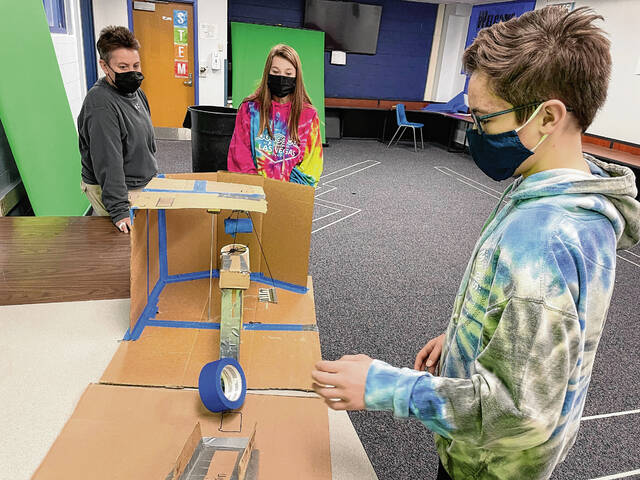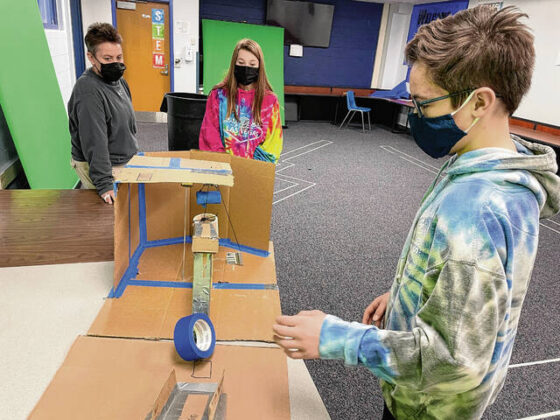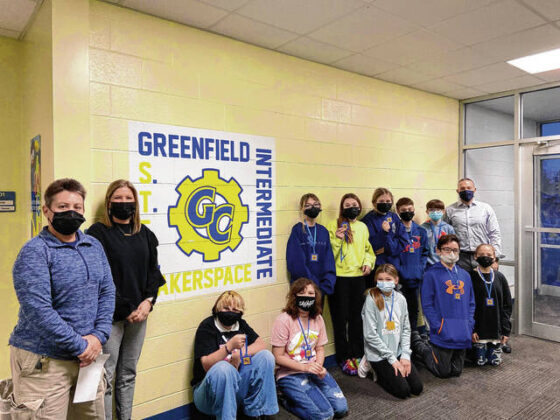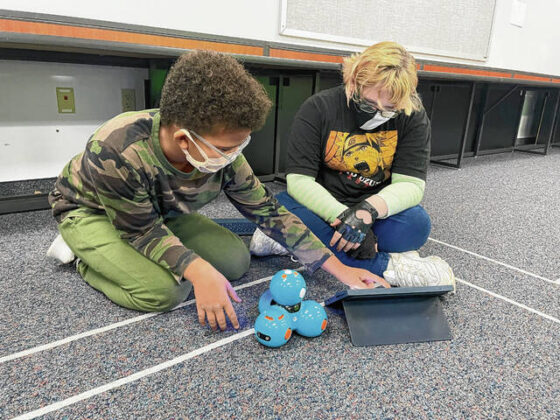
GREENFIELD — While most teachers show their students how to simplify problems, Amy Fletcher likes to teach her students how to make the simplest tasks more complicated.
The Greenfield-Central Intermediate School STEM instructor recently taught her sixth-graders a unit on Rube Goldberg, an American inventor and engineer who gained fame making cartoons depicting complicated gadgets performing simple tasks in indirect, convoluted ways.
Since then, Rube Goldberg contests have been held throughout the world — challenging participants to create the most complicated contraptions using what Goldberg defined as six simple machines: a pulley, a lever, a wedge, an inclined plane, a screw and a wheel and axle. Purdue University puts on one of the most prestigious Goldberg contests.
This month, Fletcher had her sixth-graders design cartoons depicting a Rube Goldberg machine. Those who she said “knocked it out of the park” were invited to turn their cartoons into actual projects.
Those who did were rewarded with a blue and gold medal resembling the school’s STEM logo, which Fletcher created on a 3D printer.
Sean Fannin was among those students who scored a medal for his efforts.
He crafted a machine out of cardboard that turned the simple task of raising a white flag into a four-step process.
Sean demonstrated the steps by letting a roll of duct tape roll down a ramp, which in turn knocked over a cardboard hammer that was sitting upright. The hammer then fell down and tipped over a tiny bucket, causing a pulley to hoist a tiny white flag into the air.
“STEM (science, technology, engineering and math) teaches you how to build things using what’s around you,” said the 12-year-old, who thought the assignment was a lot of fun.
Fellow sixth-grader Kaiden Frischkorn also got a kick out of constructing a Rube Goldberg machine.
“I think it’s really cool to build something using a bunch of different (simple) machines,” she said.
Both students said the project taught them problem-solving skills, which Fletcher said was the whole point of the assignment.
“I think they learn more from failure than they do from success. You have to keep trying,” she said.
Goldberg’s mission in creating his cartoons was to encourage people to embrace technology as a simpler way of doing things, said Fletcher, rather than to resist advancements in favor of doing things the harder way.
“His message was to people who were resisting technology and resisting advancements,” she said.
“A computer is technology. A pencil is technology. They’re all tools we can use to make life easier. His message was for people to embrace technology and not make things harder than they need to be.”
Flipping that process in reverse is what designing Rube Goldberg machines is all about, she said.
“It all boils down to problem solving. There are problems that tend to be solved in every job,” Fletcher said. “Every boss needs employees who can look at something and think, ‘That’s the problem. How can we solve it?’”
When a few of her students grew frustrated when their Rube Goldberg projects weren’t working, Fletcher assured them that was OK.
“It’s in the pursuit of making it work where you’re learning. I think that’s very valuable,” she said.
”There’s not a lot we all do that we get 100% right the first time. You have to learn not to throw in the towel. The whole point of the building process is designing and engineering it. If it doesn’t work, you redesign and re-engineer until it does.”
Fletcher, a former band teacher and the daughter of an electrical engineer, said she’s enjoying her first year teaching STEM classes.
When she was informed she’d be teaching STEM to each of Greenfield Intermediate’s 500-plus students this year, she attended online conferences and workshops, reading up and watching YouTube videos to learn all she could.
She also bought a 3D printer she used to create the STEM medals she recently gave out.
This month, she’s teaching computer coding, helping students program robots to glide and spin around the classroom floor.
She plans to have her sixth-graders build Rube Goldberg machines each year, as part of a learning unit on how roller coasters operate.
She was hoping to take them to see Purdue’s Rube Goldberg contest this year, but the annual event was canceled due to COVID, so the students watched videos of past events instead.
“Purdue’s contest draws entries from all over the country. Those students spend an unbelievable amount of hours designing and building them,” she said, as her fifth-grade students sent tiny robots spinning past her feet on the classroom floor.







